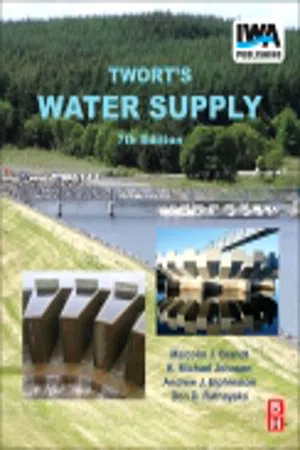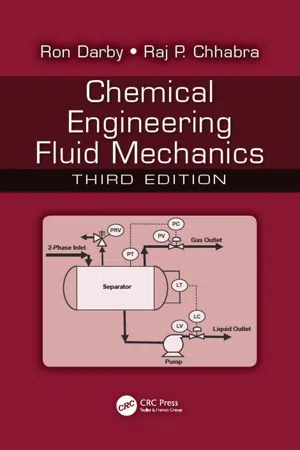Technology & Engineering
Colebrook Equation
The Colebrook equation is a mathematical formula used to calculate the friction factor in fluid flow. It is commonly used in engineering and physics to determine the pressure drop in pipes and channels. The equation takes into account the roughness of the pipe wall and the Reynolds number of the fluid.
Written by Perlego with AI-assistance
Related key terms
Related key terms
1 of 4
Related key terms
1 of 3
4 Key excerpts on "Colebrook Equation"
- eBook - ePub
- Malcolm J. Brandt, K. Michael Johnson, Andrew J. Elphinston, Don D. Ratnayaka(Authors)
- 2016(Publication Date)
- Butterworth-Heinemann(Publisher)
f is not constant but varies with the size of pipe and the degree of turbulence of the flow.Colebrook–White Formula
Colebrook and White showed that f in the Darcy–Weisbach formula is a function of the relative roughness of the pipe surface, the viscosity of the flow and the Reynolds number, Re . From a combination of theoretical analysis and empirical data they showed that:which can also be written as:1 f= − 2log 10{}+k s3.71 d2.51Re f1 f= − 2log 10{}+k s3.71 d2.51( d2 g d i)where i is the hydraulic gradient , H/L , the rate of energy loss along the pipe; k s is the roughness of the internal surface of the pipe; ν is the kinematic viscosity of the water.The experimental data showing variation of f with Reynolds number and relative roughness was plotted by Moody and forms the basis of the diagram illustrated in Figure 14.2 . Thus the Colebrook–White equation is, in effect, a mathematical representation of the Moody diagram. The formula now widely known as the Colebrook–White equation is a formulation of the Darcy–Weisbach equation with f replaced. It is usually written as:V = − 2(14.4)( 2 g d i )⋅log 10[]+k s( 3.71 d )2.51 v( d2 g d i)(14.4)Equation (14.4) can be solved directly only for V (and hence Q ), knowing d and i . More commonly it is required to find i , knowing Q and d . The equation is then not explicit but must be solved using an iterative technique of successive approximations. The Colebrook–White equation, or one of the approximations such as given below allowing a direct solution, is now widely applied and is recommended as the formula to be used to estimate pipeline headlosses. One of the advantages of this equation over the empirical formulae discussed below is that the roughness coefficient, k s is a function only of the surface roughness of the pipe and does not change with the size of the pipe or velocity of the flow. The factor k s is sometimes referred to as the equivalent sand roughness because the original experiments carried out by Nikuradse utilized sand grains stuck to the inside of the pipes. The value of k s is meant to represent the equivalent diameter of the sand particles giving that degree of roughness. Although this is only a notional concept, it does provide a physical meaning to the roughness measurement, which does not apply to the coefficients in any of the empirical formulae given in Section 14.5 - eBook - ePub
- E. Shashi Menon(Author)
- 2004(Publication Date)
- CRC Press(Publisher)
Consider a 100 mile pipeline, 16 in. diameter, 0.250 in. wall thickness, transporting a liquid (specific gravity of 0.815 and viscosity of 15 cSt at 70°F) at a flow rate of 90,000 bbl/day. Calculate the friction factor and pressure drop per unit length of pipeline using the Colebrook-White equation. Assume a pipe roughness value of 0.002.SolutionThe Reynolds number is calculated first:Using the Colebrook-White equation (3.30) , the transmission factor isF = −4 Log10 [(0.002/(3.7 × 15.5)) + 1.255F/35,706]Solving above equation, by trial and error, yields F= 13.21To calculate the friction factor f, we use Equation (3.29) after some transposition and simplification as follows:Friction factor f = 4/F2 = 4/(13.21 )2 = 0.0229The pressure drop per mile is calculated using Equation (3.28) :Pm = 0.2421(90,000/13.21)2 (0.815/15.55 ) = 10.24 psi/mileThe total pressure drop in 100 miles length is then Total pressure drop = 100 × 10.24 = 1024 psi3.7 Colebrook-White Equation
In 1956 the U.S. Bureau of Mines conducted experiments and recommended a modified version of the Colebrook-White equation. The modified Colebrook-White equation yields a more conservative transmission factor F. The pressure drop calculated using the modified Colebrook-White equation is slightly higher than that calculated using the original Colebrook-White equation. This modified Colebrook-White equation, in terms of transmission factor F, is defined as follows:In SI units, the transmission factor equation above remains the same with e and D expressed in mm, other terms being dimensionless.Comparing Equation (3.34) with Equation (3.30) or (3.33) , it can be seen that the only change is in the substitution of the constant 1.4125 in place of 1.255 in the original Colebrook-White equation. Some companies use the modified Colebrook-White Equation stated in Equation (3.34) .An explicit form of an equation to calculate the friction factor was proposed by Swamee and Jain. This equation does not require trial-and-error solution like the Colebrook-White equation. It correlates very closely with the Moody diagram values. Appendix C - eBook - ePub
- Ron Darby, Raj P. Chhabra(Authors)
- 2016(Publication Date)
- CRC Press(Publisher)
PROBLEMSIt may initially be assumed that the flow is fully turbulent, the pressure drop in the header is negligible, and the losses in the tees corresponded to fully turbulent flow. For fully turbulent pipe flow, the limiting form of the Colebrook can be used, that is,f =(21)4 log[3.7 /](ε/ D)(6.40) If the pressure drop in the header is initially neglected, Equation 7.68 can be used to calculate the flow rate in the branches (which will be approximately equal in each branch) and hence the total flow rate from Equation 7.69 . These flow rates can then be used to calculate the pressure drop between each node in the header and the branches. These pressure drops are then used to revise the flow rates and the procedure repeated until there is an agreement with the inlet pressure.The output of a spreadsheet used to solve this problem is shown in Table E7.1 . Only the first and the last iterations are shown in this table. In order to initiate the solution, f = 0.005 and the value of K∞ were assumed, as the Reynolds number is unknown. However, all subsequent iterations are based on the actual values of f and Kf calculated from the Churchill equation and the 3-K method. The spreadsheet calculations are carried out by first assuming a value for P2 (or h2 = P2 /ρg) and checking the continuity of the flow rates for agreement. Then the value of h2 is adjusted until these checks are in reasonable agreement.TABLE E7.1 Spreadsheet Output for Example 7.3Note: Values of A and B are calculated from Churchill Equation (6.41).All values of “h” variables are in units of ft of head.a Use Table 7.3 to calculate updated values of K.1. You must size a pipeline to carry crude oil at a rate of 1 million bbl/day. If the viscosity of the oil is 25 cP and its SG is 0.9, what is the most economical diameter for the pipeline if the pipe costs $3/ft of length and per inch of diameter, the power cost is $0.05/kWh, and the pipeline cost is to be written off over a 3 year period? The oil enters and leaves the pipeline at atmospheric pressure. What would the answer be if the economic lifetime of the pipeline is 30 years?2. A crude oil pipeline is to be built to carry oil at a rate of 1 million bbl/day (1 bbl = 42 gal). If the pipe cost $12/ft of length per inch of diameter, power to run the pumps costs $0.07/kWh, and the economic lifetime of the pipeline is 30 years, what is the most economical diameter for this pipeline? What total horsepower would be required of the pumps if the line is 800 miles long, assuming 100% efficient pumps? (Oil: viscosity = 35 cP, density = 0.85 g/cm3 - eBook - ePub
Working Guide to Pump and Pumping Stations
Calculations and Simulations
- E. Shashi Menon(Author)
- 2009(Publication Date)
- Gulf Professional Publishing(Publisher)
Initially, we assume a value for f (such as 0.02) and substitute the values into the right-hand side of Equation (4.21). A second approximation for f is then calculated. This value can then be used on the right-hand side of the equation to obtain the next better approximation for f, and so on. The iteration is terminated, when successive values of f are within a small value such as 0.001. Usually three or four iterations are sufficient. As mentioned before, for the critical flow region (2000 < R < 4000), the friction factor is considered undefined, and the turbulent friction factor is used instead. There have been several correlations proposed for the critical zone friction factor in recent years. Generally, it is sufficient to use the turbulent flow friction factor in most cases when the flow is in the critical zone. The calculation of the friction factor f for turbulent flow using the Colebrook-White equation requires an iterative approach, since the equation is an implicit one. Due to this, many explicit equations have been proposed by researchers that are much easier to use than the Colebrook-White equation, and these have been found to be quite accurate compared to the results of the Moody diagram. The Swamee-Jain equation or the Churchill equation for friction factor may be used instead of the Colebrook-White equation, as described next. Explicit Equations for the Friction Factor P. K. Swamee and A. K. Jain proposed an explicit equation for the friction factor in 1976 in the Journal of the Hydraulics Division of ASCE. The Swamee-Jain equation is as follows: ((4.22)) Another explicit equation for the friction factor, proposed by Stuart Churchill, was reported in Chemical Engineering in November 1977. It requires the calculation of parameters A and B, which are functions of the Reynolds number R
Index pages curate the most relevant extracts from our library of academic textbooks. They’ve been created using an in-house natural language model (NLM), each adding context and meaning to key research topics.
Explore more topic indexes
Explore more topic indexes
1 of 6
Explore more topic indexes
1 of 4



